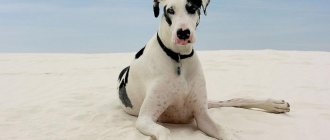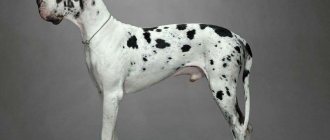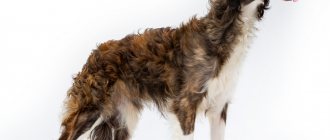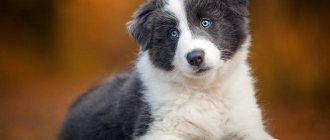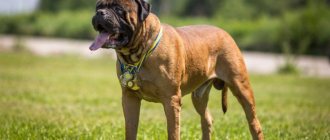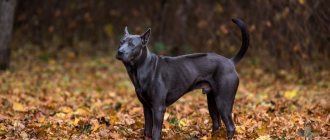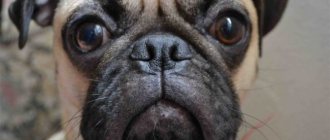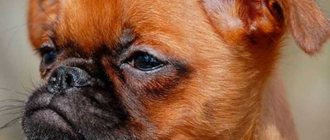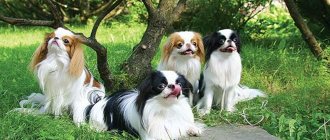The Russian Greyhound represents aristocracy and elegance among dogs. Looking at the representatives of this breed, it’s as if you yourself find yourself in the last century, when their distribution was especially popular. The greyhound's unique speed qualities, strength and endurance, and bright appearance - all this makes it popular today. Future owners often ask a lot of questions regarding the peculiarities of keeping and raising dogs. After reading the article, you will learn interesting facts about the origin, upbringing and characteristics of the Russian Greyhound breed.
History of the breed
The Russian greyhound is one of the ancient hunting breeds. The first descriptions of these dogs date back to the seventeenth century. In Rus', greyhounds appeared along with the Mongol-Tatar hordes.
The formation of the breed took place on the territory of Russia; it is this country that is considered the birthplace of the Russian greyhound. In the first half of the eighteenth century, the following breeds were used in breeding work on this type of dog: Hort greyhounds, English greyhounds, and chesty greyhounds. This, as they say, is a European infusion into the Russian greyhound breed. The breeders didn't stop there. With the advent of the nineteenth century there was another infusion, this time from the East. In order to improve the Russian dog, crossings were carried out with Crimean and mountain dogs.
As a result of such diverse selection, many different representatives of the breed were formed that cannot be described in one way. The first standard was approved in 1888. Purebred Russian greyhounds are close to the same type in appearance.
In the old days, it was considered prestigious among landowners to keep packs of greyhounds in their kennels. Moreover, in one pack there were not 10 or even 50 individuals, there were usually more than a hundred dogs. The larger the pack, the more wealthy their owner was considered. It is worth noting that Russian greyhounds were called by the owner's last name. In 1873, the breed was on the verge of extinction. To save the endangered species, the Imperial Association was created, but it did not fulfill its mission, as it disappeared along with the aristocratic society.
During the period of the revolutionary upheaval and the coming to power of workers and peasants (1918), dogs of this type ceased to be popular, they were simply destroyed. The common people considered them an integral part of the landowners, bourgeoisie, aristocrats, and royalty. The Russian greyhound managed to survive and retain its purebred qualities only due to the fact that many dogs were exported to America and European countries at the end of the nineteenth century.
In addition to being an ideal hunter, the Russian Greyhound participates in exhibitions and various sporting competitions, for example, in racing after moving baits.
Russian greyhound: special breed exhibitions for 2022
| Club | City | start date | expiration date | RANK |
| MOROO “CANINE BREEDING CENTER” | Bulatnikovskoe | 18.09.2022 | 18.09.2022 | CCC in each class |
| MOKO “RUSSIAN SPACE” | Vidnoe | 06.08.2022 | 06.08.2022 | CCC in each class |
| VGOO CS “SIRIUS” | Vologda | 03.09.2022 | 03.09.2022 | CCC in each class |
| KRKOO “SARMAT” | Dzhankoy | 03.04.2022 | 03.04.2022 | KCHK |
| SROO “CLV” | Zarechny | 11.06.2022 | 12.06.2022 | CCC in each class |
| IGOO “GOLS” | Irkutsk | 04.06.2022 | 04.06.2022 | CCC in each class |
| KKOO KKLZH RING | Krymsk | 15.05.2022 | 15.05.2022 | KCHK |
| MOOOLS “Venets Kolyma” | Magadan | 15.10.2022 | 15.10.2022 | CCC in each class |
| MGOO “DOG BREEDING CLUB “ZOOMIR” | Miass | 13.08.2022 | 13.08.2022 | KCHK |
| MCOO ATLANTIS | Moscow | 06.02.2022 | 06.02.2022 | KCHK |
| MOO “KSSS “BARKO” | Moscow | 24.04.2022 | 24.04.2022 | CCC in each class |
| MOO “FEDERATION OF CYNOLOGY” | Moscow | 06.08.2022 | 06.08.2022 | KCHK |
| LLC “KK”DELTA-PAL” | Moscow | 17.04.2022 | 17.04.2022 | KCHK |
| KKOO KSHDPR SS | Novorossiysk | 21.08.2022 | 21.08.2022 | Not a member of the NCP |
| NGOLS | Novorossiysk | 12.06.2022 | 12.06.2022 | CCC in each class |
| UNGKLV “FAUNA” | Novorossiysk | 21.08.2022 | 21.08.2022 | KCHK |
| CROO “KSS “SIMARGLE” | Obninsk | 27.08.2022 | 27.08.2022 | CCC in each class |
| MOROO “FSPS” | Ramenskoye | 20.08.2022 | 20.08.2022 | KCHK |
| MOKO “KK SPB” | Saint Petersburg | 26.06.2022 | 26.06.2022 | KCHK |
| MOO “LOOIR” | Saint Petersburg | 28.05.2022 | 28.05.2022 | CCC in each class |
| SPB ROO “KK “ELITA” | Saint Petersburg | 23.04.2022 | 23.04.2022 | CCC in each class |
| SPb ROO “DOG LOVERS CLUB “DOGSITY” | Saint Petersburg | 17.06.2022 | 17.06.2022 | CCC in each class |
| MOO "KCO "FRIEND" | Sevastopol | 20.03.2022 | 20.03.2022 | CCC in each class |
| LLC “ZKLS “ELEON-DAURIA” | Chita | 25.02.2022 | 27.02.2022 | KCHK |
Breed standard
All parts of the Russian Greyhound's body indicate that such a dog is created for rapid running. From its European ancestors, the Russian greyhound inherited a sweeping run, an arched back, small ears and a narrow, long head. Asian ancestors inherited an imperturbable, proud disposition.
The main differences of this breed are: aggressiveness towards animals, excellent eyesight, great speed, narrow build, large stature, elegance. The height of adult individuals is about 68-86 cm , weight 25-47 kg.
A long neck holds a narrow, long head with a flat skull. The ears are small and set high. The dark eyes are quite large, oval, slightly protruding. The nose is large, with wide open nostrils. The jaws are powerful, the fangs are large and white. Scissor bite or straight bite. The chest is not wide. The belly is tucked, which is typical for all types of greyhounds. The tail is thin, long, saber-shaped or sickle-shaped. During movement, the Russian greyhound raises it, but not higher than the level of its back.
The limbs are bony, smooth, with well-developed muscles. The paws are narrow, oval in shape. A light step and an extremely beautiful trot are quite justifiably the hallmark of the Russian Borzoi.
The coat is thin, there is no undercoat. Can be long, silky or stiff and curly. On the neck and back the hair is wavy and longer. Almost any color is allowed. Most Russian greyhounds are white-spotted. Greyhounds with dark coats have “mazurina” - blackness of the muzzle. Bright spots on the body are a serious drawback.
Similar breed: Afghan Hound
Selection rules
A reliable, proven, responsible breeder is the main criterion for success in acquiring a good hunting breed.
When purchasing, it is recommended to carefully study the documents and passport of the animal, its pedigree. There are no strict criteria for selection. The puppy should look healthy, strong, and active. The main thing is that it is advisable to carefully examine the baby’s skin and fur. The area around the eyes and ears should be free of mucus or pus.
Maintenance and care
Of course, for hunting dogs, the ideal housing option would be a private yard with an aviary and a kennel. But it’s not for nothing that the Russian greyhound is called the dog of aristocrats. She needs comfort and feels great, despite the large dimensions, in the apartment. If the owners give up, such a dog will lie down on the sofa or bed whenever possible.
When kept in a private house, a greyhound can walk in the yard at least all day during the warm season, provided that the territory is securely fenced. But this is not enough, the owner must regularly give her the opportunity to run in the field, in freedom, where she can develop maximum speed.
When kept in an apartment, such a dog needs daily walks. Two walks are enough, 20-30 minutes each. Never let your greyhound off the leash in public places. Seeing the intended prey, she, forgetting about the rules of behavior, remembering her hunting instinct, will rush in pursuit.
At first glance, it may seem that caring for such a huge shaggy dog is very difficult. In fact, there are no particular difficulties in caring for a Russian greyhound, the main thing is that the following procedures are carried out correctly and on time:
- Brushing 3-4 times a week; during periods of heavy shedding, the Russian dog should be combed daily.
- The Russian Greyhound is clean and needs to be bathed 2-3 times a year. After each walk, wash your paws, at the same time inspecting for injuries or splinters.
- The fur between the toes needs to be trimmed as it grows.
- Inspect and clean the ears regularly (1-2 times a week), removing accumulated secretions and dirt.
- We trim the claws as they grow.
- We brush our teeth once a week with a special paste, a brush, or using bones intended for cleaning teeth, which you can buy at a veterinary pharmacy.
Due to the peculiarities of the bone structure and well-developed muscles in all parts of the body, the Russian greyhound needs special nutrition. The feed must be of high quality. Typically, owners of hunting greyhounds choose an artificial feeding method.
If adult representatives of other breeds are fed 2 times a day, then the Russian dog needs to be fed 3-4 times a day at the same time, dividing the daily norm into equal parts. This significantly improves digestion.
It is important that the greyhound takes a nap after eating; active games are contraindicated at this time. It is also important that the pet has access to cool, clean and fresh water in sufficient quantity around the clock.
Nutrition
Large individuals need sufficient food. The diet of greyhounds requires variety and good quality. These are very expensive animals to keep.
The table shows the main products and their processing options necessary for feeding a greyhound.
| Product | How to cook | What does the dog get? |
| Meat: beef, veal, lamb, horse meat | Only horse meat can be given raw; this meat is not affected by brucellosis. It is best to boil the remaining ingredients | Protein, vitamins |
| Fish – lean varieties (cod, pollock) | The animal should be fed boiled fish, having previously cleaned it of bones. | Protein, iodine, phosphorus |
| Eggs | Boiled. An adult dog should be given no more than two eggs a week, a puppy can have 3-4 | Protein |
| Vegetables and fruits | Your pet will benefit from vegetable and light soups. Hard raw vegetables are grated on a coarse grater, seasoned with butter or sour cream | Vitamins for healthy and shiny coats |
| Milk, its derivatives | Puppies benefit from milk porridge. It is better to give fermented milk products to adult dogs. In their pure form or as an additive to other foods, they are fed kefir, fermented baked milk, yogurt, and cottage cheese. Hard unsalted cheese is suitable for feeding | Calcium |
| Cereals: rice, buckwheat, rolled oats | Steam with boiling water or hot milk | Vitamins and microelements necessary for development |
You cannot feed the animal:
- bones;
- leftovers from the table;
- salty foods;
- flour products;
- fatty meat;
- offal;
- sweets;
- starchy vegetables and fruits;
- legumes
It is recommended to feed the animal by the hour; portions should be eaten to the end.
Health
The average life expectancy of a Russian greyhound is 7-10 years. The owner is responsible for the health of the animal. It is he who must annually bring the dog to the veterinary clinic for preventive examinations, x-rays, and tests.
It is important to do routine vaccinations, treatment for skin parasites and deworming on time. Please keep in mind that representatives of the breed are very sensitive to many chemicals, including anti-flea and tick products.
It is necessary to carefully monitor the physical activity of puppies and young dogs during the period when intensive growth occurs. Excessive stress can lead to serious bone problems.
The Russian Greyhound breed can be called healthy with strong immunity. It should only be noted that she is predisposed to the following health problems:
- Volvulus – Greyhounds often suffer from bloating, in most cases this is due to the pet being overly active immediately after eating.
- Increased sensitivity to anesthesia and painkillers.
- Cataract is clouding of the lens, leading to poor vision.
- Wobbler's syndrome is compression of the cervical vertebrae.
- Cardiovascular diseases.
- Oncological diseases.
General position
Dog shows NKP (National Winners Club) are held in accordance with these Regulations of the RKF and are divided into the following ranks:
- Rank CHK (National Club Champion).
- Rank PC (National Club Winner).
- Rank CC (Candidate for champion of the national breed club).
Dog breeds that are officially recognized by the RKF and FCI are allowed to participate. Organizers of a monobreed exhibition are required to check all dogs listed in the catalog to see if they are registered in the country's Pedigree Book. At all special breed exhibitions, a ring must be organized for dogs, which must receive a description from an expert (judge) of the RKF.
Character
Brief description of the Russian Greyhound – a fearless, swift hunter and affectionate companion with the manners of an aristocrat. This animal miraculously combines seemingly incompatible features.
Duality is manifested in the following: 1. In a home environment, surrounded by household members or people close to the family, the Russian Greyhound is calm, affectionate, and gentle. 2. During hunting or sports competitions, the greyhound is a bundle of inexhaustible energy, speed and anger towards the target. In a mad gallop, such a dog is not distracted by anything, not even by wounds. He becomes the complete opposite of a pampered pet.
The psyche of representatives of the breed is vulnerable and delicate. They require attention and understanding. Only with such treatment will a Russian greyhound be endlessly devoted to its owner. Rudeness and physical punishment will ruin her character; she can turn into an uncontrollable and aggressive animal.
A greyhound pet is not recommended for families with children under 7-8 years of age. The fact is that an overly impressionable hunting dog may see a threat in the actions of a small child. For school-age children, a dog can become a loyal friend.
You might be interested in our article: TOP 30 best dog breeds for children
Greyhounds do not like loneliness. Therefore, you should not leave your sociable pet alone for a long time. They do not show aggression towards strangers; their reaction to strangers is detachment, indifference or friendliness.
Due to the hunting instinct, keeping the Russian dog in the same room with other pets, especially small ones, becomes problematic. Even the most well-mannered and friendly hunting dog can have a hunter's instinct at any moment, which will have a detrimental effect on other animals.
Reviews
Our favorite Alma is a very fast, energetic dog. It is not easy and very expensive to keep such a large hunting greyhound in an apartment, but the baby has been with us for almost 10 years. Taking care of her disciplines the whole family, because every morning we go for a long run.
It is not recommended to buy a puppy not for hunting, but for apartment living. The pet will run after every cat or bird on a walk. Obedient within the walls of a house, but completely uncontrollable within the city. It is expensive to keep an animal, since a purebred and very large dog needs a balanced diet, especially good meat.
An ideal breed for baiting a hare or fox. The dogs Duke and Musketeer have been hunting with me for more than 7 years. I bought them as puppies from a reliable nursery. The breeder provided all the necessary documents. As a result, I have excellent hunting dogs. He raised and trained himself.
Before deciding to purchase a representative of this breed, you should think carefully, analyze the facts, and discuss your decision with family members. The greyhound dog is not included in the list of aggressive animals, but still is not distinguished by its submissiveness and docile nature. Expensive to care and maintain, she requires training, education, and time for communication.
Training and education
We begin raising a puppy from the first day the pet comes into the house. The Russian Greyhound is an extremely intelligent dog, but its training is not easy, since its character is stubborn and willful.
The greyhound begins to show particular obstinacy at 5-6 months. During this period, the owner must, armed with perseverance and patience, achieve obedience from the pet. Every command spoken by the owner must be carried out. Give some slack once, and the dog will instantly feel it, deciding that it is not at all necessary to obey. Aggressive training is not necessary for the Russian Greyhound.
This reserved dog requires basic obedience training. She has a highly developed hunting instinct, so it is important to teach her to unquestioningly follow the “Near” command from puppyhood.
Such a command will help control your pet’s desire to start an unauthorized chase in an inappropriate place. If you plan to use your greyhound for hunting, additional training will be required. For example, so that it does not enter into conflicts with other hunting dogs during a hunt and does not spoil the animal, it is first boiled.
Interesting Facts
- The Russian Greyhound has exceptional hearing and acutely developed vision; such a dog is capable of detecting prey running across a field from a distance of 800 meters.
- During a rapid dash, a greyhound can reach speeds of up to 90-100 km. hour.
- From an ambush, a Russian canine can make a three-meter long jump from a standing position.
- The running of representatives of the breed is so swift and easy that an observer from the outside creates the appearance of a dog running through the air. His feet don't seem to touch the ground.
- Abroad, representatives of the breed are called “Russian Wolfhound”. Indeed, the Russian greyhound is capable of handling a wolf alone. Since ancient times in Rus' these dogs have been used in wolf work.
Mating
A girl's first heat occurs at the age of 1 year. However, this does not mean that the dog is ready for mating. The optimal age for mating a girl is 1.5 years.
Experts recommend choosing the time for mating greyhounds - mid-winter. In the spring, the puppies can be distributed. When a young body grows up, it will not be afraid of the cold.
How much does it cost and how to choose a puppy
It is best to purchase puppies from an official nursery. However, their cost is quite high. On average, a puppy for exhibitions can be purchased for 40-60 thousand rubles*. A hunting dog sells for 20-30 thousand. If a person only needs a pet, then it can be taken within 15 thousand.
Puppies
